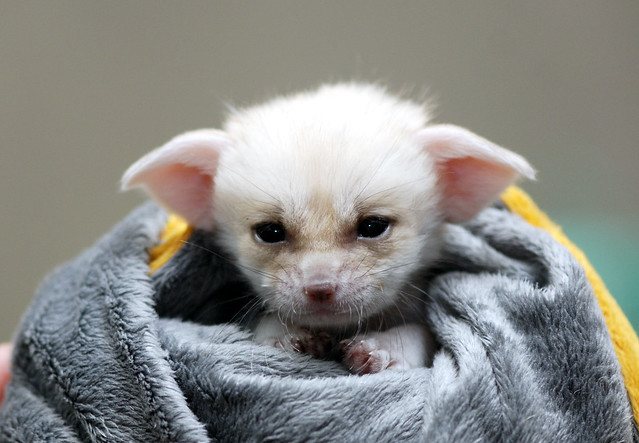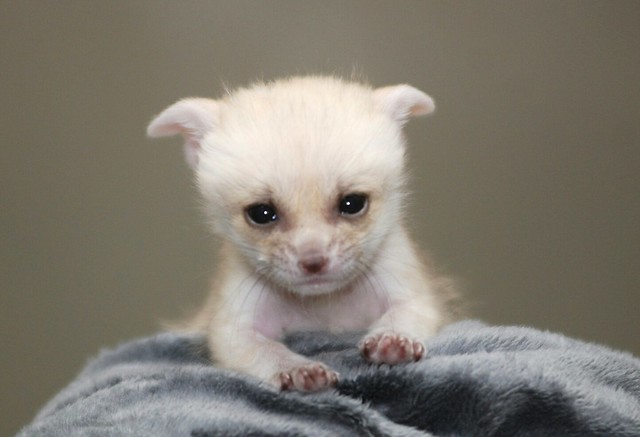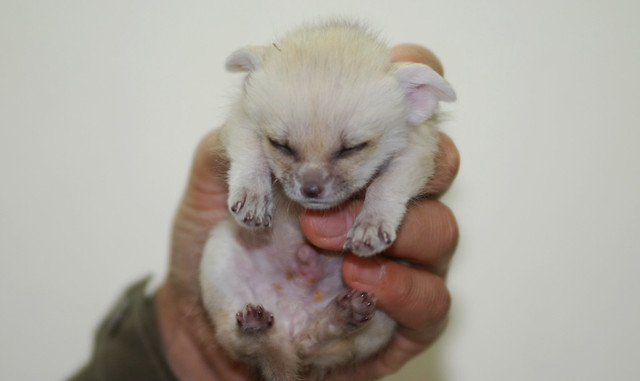What Do You Call a Baby Wolverine Fennec Fox
Fennec Fob
Nosotros figured no ane would complain if we shared boosted photos of Chattanooga Zoo's Fennec Fox kits, then here goes! Here is the pair when they were a bit younger, and getting into all kinds of mischief!
Did you know that the Fennec Fob is ZooBorns' unofficial mascot? The Fennec Flim-flam graces the cover of our original all ages book, ZooBorns (below). Accept a tour of the volume on Amazon and go it in time for the holidays. With interesting animal facts and background stories on the featured babies, ZooBorns (Hardcover, 160 pages) illustrates the connections betwixt zoo births and conservation initiatives in the wild. 10% of revenue from ZooBorns' book sales goes directly to the Association of Zoos and Aquariums' Conservation Endowment Fund.
Get it now on Amazon!
Ii Fennec Fox sisters were born at Chattanooga Zoo in Tennessee! They have only been named Zahari, meaning blue in Arabic, and Zeiti, meaning green in Standard arabic. (To tell the sisters apart, they were each given a small spot of food coloring either blueish or green on their backs.)
They were born on September 11, 2013 to first-fourth dimension parents, mother Karoo and father Kalahari. The kits are incredibly active and are growing bigger by the day. They are very curious and playful and honey to investigate new toys, sounds, and smells. When full grown, they volition join the zoo's animal ambassador and teaching programs, where they volition play an important role in raising awareness about wildlife conservation.
Photo credits: Chattanooga Zoo
Fennec Foxes (a ZooBorns favorite!) live in the deserts and semi-arid lands of northern Africa. Also called the Desert Fox, their nearly notable feature are their ears, which are enormous in proportion to their body size. An developed Fennec Fob measures about 16 inches (forty cm) in body length and has ears 6 inches (xv cm) long. These huge ears are used for cooling the body of excess heat and for locating prey, such as lizards, insects, and eggs, buried deep under the desert sand. Fennec Foxes are a species of Least Concern on the International Union for Conservation's Cherry Listing of Threatened Species.

Time for a ZooBorns classic: Fennec Foxes! These little newborns were recently photographed at Everland Zoo in Seoul, Korea, past zoo lensman In Cheryl Kim. Last yr, we crunched the numbers and found that a Fennec Fox photograph by In Cheryl Kim was the number one cutest film featured on our website, single-handedly bringing 500,000 new visitors to the ZooBorns website. (See those meridian 25 photos here.) The Fennec Fox has since become our mascot. To browse through our previous Fennec Flim-flam posts— they are truly adorable—click here.
Fennec Foxes are endemic to the Sahara Desert, where their big ears allow them detect insects dancing across the sand at dark and fur lined paws protect them from scorching hot sand during the solar day. They are the smallest species of canid in the globe. And at that place's adept news: the International Union for Conservation of Nature lists the Fenne Play a joke on as a species of Least Concern, pregnant that they are common throughout their range and don't seem to be declining.


 Photo credits: In Cheryl Kim / Everland Zoo
Photo credits: In Cheryl Kim / Everland Zoo
Caretakers at Artis Zoo in Amsterdam are keeping an eye out for kits in their Fennec Play a trick on exhibit. The mother has quietly given birth to at least two male kits since July 2nd, merely information technology all the same isn't clear exactly how many have been built-in. Every now and and so, caretakers take caught a glimpse of some kits and heard little squeaks coming from behind stumps and other hiding places.
Photo credits: Ronald van Weeren / Artis Zoo
Fennec Foxes alive in the deserts and semi-arid lands of northern Africa. Also called the Desert Fox, their nigh notable feature are their ears, which are enormous in proportion to their body size. An developed Fennec Fox measures most sixteen inches (40 cm) in trunk length and has ears six inches (15 cm) long. These huge ears are used for cooling the body of backlog heat and for locating prey, such every bit lizards, insects, and eggs, cached deep under the desert sand. Fennec Foxes are a species of Least Business organization on the International Spousal relationship for Conservation's Scarlet List of Threatened Species.
County Executive Joanne M. Mahoney joined New York's Rosamond Gifford Zoo staff to introduce their newest Fennec Play a trick on kit. Born on the afternoon of March 23 to parents Rhiona and Copper, he weighed approximately 40 grams (that'southward less than a hard-boiled egg). Regardless of his atomic size, he was named Moose! Today, at just about two months old, he'due south one-half-grown at 455 grams. Mahoney said, "Information technology'south bully to see notwithstanding some other testament of the zoo staffs' dedication to furthering creature conservation and protecting endangered species."
Ted Play tricks, Curator and Zoo Manager siad, "Fennec Trick parents are very cautious and elusive during the kit rearing process. Due to their astute hearing and sensitivity, reproduction of Fennec Foxes in a zoological setting is a challenge. Hand-raising this kit will habituate him to close contact with humans, helping him to get a confident and well-adjusted adult."
Photo Credit: Photos i,2: Rosamond Gifford Zoo, Photo iii: CNY News
Fennec Foxes are institute throughout the deserts of Northward Africa and the Sinai and Arabian peninsulas. 1 of the smallest of canines, Fennec Foxes are well built for their natural habitat. Their nocturnal habits help them survive in the searing heat of the desert environment, and some physical adaptations help, likewise. Their distinctive bat-like ears human action like natural air conditioners, radiating heat away from their bodies, and assuasive them to hear the movements of predators and prey over long distances. They accept long, thick hair that insulates them during cold nights and protects them from the hot dominicus during the solar day. Fifty-fifty the bottoms of their feet are hairy, which acts as a barrier confronting the extremely hot sand in their native desert environment.
Read More after the fold:
Continue reading "Meet Little Moose, Rosamond Gifford Zoo'south Newest Fennec Flim-flam Kit" »
Commonwealth of australia'southward Taronga Zoo welcomed three Fennec Fob infants, the first to be born to a new convenance pair from Europe. The kits, which are but starting to sally from their nest box, were built-in on December 19, 2012, a twelvemonth after the zoo introduced their parents, Zinder and Kibali, a new breeding couple from Europe.
Carnivore Keeper Tamara Bell said, "Any new arrival is special, simply what makes these Fennec kits fifty-fifty more important is that they're the first offspring born to Zinder, the male who came from Germany, and Kebilli, the female from Poland. This means that these kits are not related to any of the Fennec Foxes here in Commonwealth of australia."
Photo Credit: Rick Stevens
Aside from expanding the genetics in the Australasian region, the young Fennec Foxes have likewise provided a boost to the convict population of the species, which dropped to only six throughout Commonwealth of australia prior to 2010.
Fennec Foxes are the smallest of the canines, growing upward to only sixteen inches (40 cm) and weighing upwards to three.3 pounds (1.v kg'due south). Their singled-out feature is their large ears that dissipate body oestrus and keep them cool. Commonly constitute in the deserts of Sahara and North Africa, Fennec Foxes are burrowing animals that dig tunnels as deep as xv anxiety (iv.5 k), where their kits are reared.
Read more about the kits, and come across more than pictures, later the fold:
Keep reading "New Bloodline of Fennec Foxes Built-in at Taronga Zoo" »
Syracuse, New York's Rosamond Gifford Zoo announced today the first nascency of Fennec Fox kits in 21 years. The birth is a bang-up breeding success for a species which is notoriously difficult to reproduce. Fennec Foxes are found throughout the deserts of North Africa and the Sinai and Arabian peninsulas. Their nocturnal habits help them survive in the searing heat of the desert environment, and some physical adaptations assistance, as well.
Their big ears not only help them locate insects, just they as well help them to dissipate the harsh desert rut. Long, bushy tails serve as congenital in scarves which Fennecs wrap around their noses to keep warm when temperatures drib at night.
Photo credit: Amelia Beamish, taken at Rosamond Gifford Zoo
Fennec Foxes are part of a Species Survival Plan (SSP) - a collaborative attempt betwixt the Association of Zoos and Aquariums and zoos around the world to aid ensure their survival.
See many more pictures and acquire more beneath the fold...
Go along reading "Meet Rosamond Gifford Zoo'due south Beginning Baby Fennec Foxes in 21 Years!" »
Palm Beach Zoo'due south newest arrivals are five Fennec Trick kits. The kits are approximately vii weeks sometime, though their exact historic period isn't known, since they were safely tucked away in an underground burrow until earlier this calendar month when they began to venture out to encounter their adoring public.
Fennec Foxes are one of the smallest flim-flam species. Large ears allow the Fennec to hear the movements of its enemies and prey over long distances, which is very important for a desert brute. It can even hear its prey moving underground. Fennec Foxes tin be found throughout the deserts of North Africa and the Sinai and Arabian Peninsulas. Fennecs avert the worst heat of the desert by living in burrows during the day and emerging but in the cool of the night. They dig their burrows at the base of operations of small hills or in other places where moisture is probable to be retained for long periods of time. Despite the desert'due south lifeless advent, at that place are in fact a big number of beast species bachelor for the Fennec to feed on. Scorpions, spiders and beetles make upwardly the majority of the Fennec'due south nutrition in the wild.
Photograph credits: Palm Beach Zoo / Brett Bartek
The Palm Embankment Zoo actively participates in the Clan of Zoos and Aquariums (AZA) Species Survival Plan (SSP) for fennec foxes and has exhibited the species since 1995. Since then, the zoo has had ix successful births bringing the yard full of fennec foxes on zoo grounds to xiii. Initiated in 1981 by the AZA, Species Survival Plans strive to manage chosen species and help maintain healthy, diverse populations that may become self‐sustaining in the hereafter. SSPs also help with field projects in home range areas, assistance educate the public, and provide funding for research and reintroduction of animals back into the wild, when appropriate.
Meet Lulu and Roscoe, the Milwaukee County Zoo's newest Fennec Play a joke on kits. Born January 27th, the cubs recently made their public debut accompanied by mom, Daisy, and father, Duke. Fennec foxes' oversized ears deed similar natural air conditioners, radiating oestrus away from their bodies and cooling their blood in the light desert breeze. Their ears likewise assist discover tasty casualty at night, including small insects scurrying most-silently atop the sand.
Keepers describe the kits every bit very playful, enjoying their toys and rough-housing with each other.
Photograph credits: Milwaukee County Zoo
Photo credits: Safari Westward
Santa Rosa CA's Safari West shared a new picture of their Fennec Fox kits Bella and Bill.
The pair (as well as their radar-similar ears!) are growing upward fast. Bring together us on Facebook to caption this photo in the comments section.
Source: https://www.zooborns.typepad.com/zooborns/fennec-fox/page/2/

0 Response to "What Do You Call a Baby Wolverine Fennec Fox"
Enregistrer un commentaire